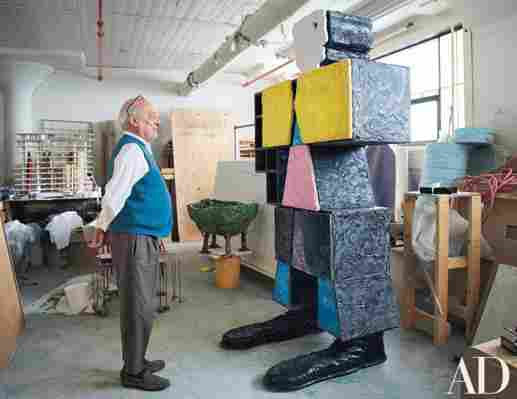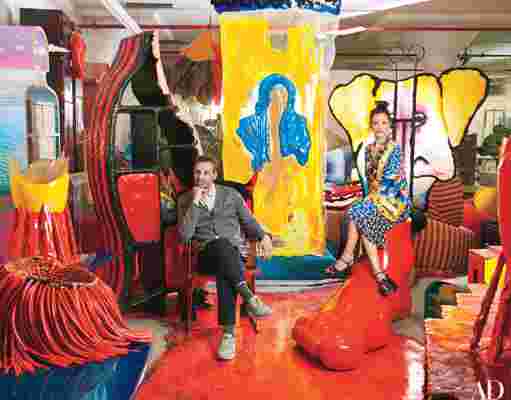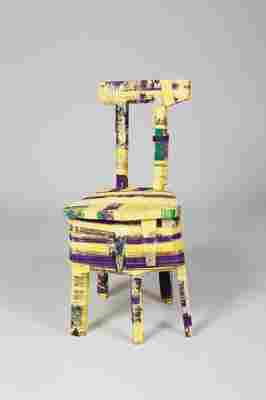Jeanne Greenberg Rohatyn and Paul Johnson On Art, Identity, and the Beauty of Imperfection
At Design Miami this past year, discerning eyes immediately zeroed in on Salon 94, whose booth displayed a series of cabinets by Italian iconoclast Gaetano Pesce. Holding court was not only gallery founder Jeanne Greenberg Rohatyn but also, to much excitement, her new collaborator—Paul Johnson of Johnson Trading Gallery . “I had been looking for a design partner, a partner in crime, who could really get their hands dirty,” notes Greenberg Rohatyn. “Paul is at artists’ studios every day, talking about the underside of an object.” After stealing the spotlight in Miami, the duo officially launched Salon 94 Design, in March, with a group exhibition titled Ghost Dog (a reference to Jim Jarmusch’s 2000 samurai movie) at Greenberg Rohatyn’s Bowery space in Manhattan. With their rosters of talent merged, Johnson and Greenberg Rohatyn are now organizing a group show in conjunction with the contemporary art gallery Maccarone that opens at Lever House on May 5, and plans are in the works for a permanent New York space. AD sat down with Greenberg Rohatyn, Johnson, and Pesce at the designer’s Brooklyn studio to learn more about what’s in store.



AD: Your booth in Miami was such a fantastic surprise. How did you begin working with each other?
JGR: Gaetano entered the picture when I visited his studio with RoseLee Goldberg of Performa. A cloud of dust fluffed up as we entered the space. We immediately clicked. He’s been using this radical language that young designers, including so many Paul is involved with, are also thinking about. Gaetano is the perfect role model for them.
PJ: When Jeanne mentioned Gaetano, I was like, “Yeah, let’s do that. Let’s go see him now.” In Miami, everyone kept saying, “Why didn’t I think of that? Where has Gaetano been?” It was lightning in a bottle.
AD: Your first official exhibition was a group show. Did Pesce’s groundbreaking language provide the common thread?
PJ: This new partnership is very samurai. We want to attack what the design world is and create something completely new. So it didn’t necessarily make total sense why these designers were all in the same show.
JGR: It’s about breaking down barriers and borders. The lights that we asked Gaetano to make for Ghost Dog, they’re also reliefs. They function both as lights and as something else. That blurring is something we’re interested in.
AD: So, you feel that art can be functional?
JGR: Oh, absolutely.
AD: Gaetano, tell us about the lights.
GP: They’re badly done. So they are not traditionally beautiful, but it is another beauty. Today we know that there is not one beauty but millions. We are human, full of problems, mistakes. Why anyone continues to pursue perfection, I don’t know.
PJ: I’ve never represented designers that do that kind of perfect feel. Most of them, like Gaetano, are making things with their hands. Each piece comes out a little bit different, a little bit rough. Even when I first started dealing vintage, the designers that I was attracted to all worked in that mold, designers such as Nakashima, Paul Evans.
JGR: People today want furniture in their home that’s as fulfilling and individualized as the artwork on their walls. It’s about the handmade and it’s about the now.
PJ: A lot of designers get in these ruts where they have a hit. They do an edition and then they tweak it a little bit and they do another. It’s the same language over and over again because they know it sells.
GP: It is a question of freedom. You have to be free from the outside, free from yourself. And as soon as you have an image that you repeat, it means that you are not free from yourself.
AD: Does moving away from perfection mean moving away from geometry?
GP: Geometry has been over for a long time. I cannot create emotion with a square. To tell stories, it must be anthropomorphic.
JGR: Geometry is typically what organizes us if we’re talking about architecture. But in fact, we’re now thinking about a different type of architecture, one based on human forms. Technology allows us to do so. It’s very exciting. Technology has caught up with Gaetano’s ideas.
GP: The figure is the way to represent everything. And architecture, as Jeanne said, has to express itself with something that people understand.
JGR: Your Donna chair was based on a fertility goddess. It all goes back to the figure. AD: Gaetano, you were born in Italy but have lived in New York for 37 years. How does the city inform what you do?
GP: New York is the most powerful place to live. There is no homogeneity—you cross one street and there is a totally different population. Minorities here can keep their identity.
JGR: We are in this incredible city with so many exciting spaces and we have the opportunity to plop down and do our work in almost any of them.
PJ: Designers don’t normally have the chance to show at Lever House. This is a whole new thing—giving them the opportunity to say what they want to say, beside other artworks of the same moment. There are people working now who have more in common than they probably think. Even though their work looks totally different, their thinking or approach might be the same. Putting them together in one space is our job.
AD: What can you tell us about that show?
JGR: We’re allowing the artists to be our guides. For example, Gaetano is in the process of experimenting with a hanging lamp and a resin pour on the floor. That will lead us to another work of art and another. You just have to listen. Two weeks ago I would have said the show is going to be dystopian because I woke up and read the news and it’s very depressing. But you know what? Then I came to Gaetano’s studio and he’s got optimism— he’s upbeat and he’s experimenting.
GP: I cannot believe in the past. I believe in the future.
JGR: It’s a funny moment because we’re not going to have these old, white-guy ideas much longer. It’s the last breath of that. Now is about privileging creativity and imagination.
AD: Gaetano, you’ve said that you work in the eld of creativity.
GP: Yes. We are not always designers. We are not always artists. Sometimes we go to see a movie. When it’s time to sleep we sleep, we don’t do design.
JGR: Well, actually, you do. [Laughter.] He’s designing all the time.
GP: This static vision of the job is really in the past. One day we can be a designer, the day after, an artist. Duchamp was already like that.
JGR: He played chess.
GP: He was taking an industrial object and he was putting it in a gallery. That was one of the first acknowledgments that design is art.
JGR: Duchamp understood that it’s the pedestal of the gallery that allows you to have that dialogue. That’s the exciting part of our jobs. We get to play.
For the full story, subscribe now and get the digital edition immediately.